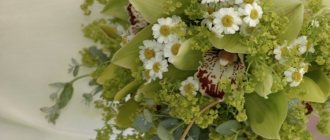Places where lily of the valley grows
The plant is found in temperate latitudes of the Northern Hemisphere, growing in the vast expanses of Europe, Asia Minor, the Caucasus, China and North America. This shade-loving flower most often grows in forest areas (usually hiding under the shade of oaks, pines and aspens) on moist soils, but often forms extensive clumps on the edges of open glades. It also grows in the mountains, where it is found at an altitude of up to 1.5 km.
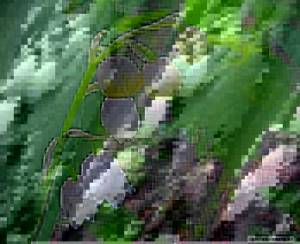
Gardeners have long fallen in love with the May lily of the valley, making it one of the clear leaders in the landscape design of spring gardens. Breeders have bred various varieties distinguished by the largest flowers. In hybrid forms, the flowers are often double and even of an unusual pink shade.

Various garden forms of the fragrant flower existed and were widely used by Europeans when decorating gardens since the 16th century. In Russia, the first lilies of the valley appeared only at the end of the 18th century; initially they were used exclusively in medicine. Now in some Russian regions these flowers are among those listed in the Red Book and protected by law.
History of the name and main types

It is believed that the word “lily of the valley” comes from the scientific name of the plant in Latin, which was awarded to it by the botanist Carl Linnaeus. The translation of the name means “lily growing in the valley.”
People often call the flower “lily of the field”, along with the definitions “forest bell”, “doe ears” (for the characteristic shape of the leaves elongated upward), “rabbit ears”. There is a version that the name is associated with a fragrant aroma, widely used in perfumery, and comes from a combination of the words “incense”, “to breathe”.
Below are the main varieties, including wild lilies of the valley and garden varieties.
May

The most famous and most popular species, which is found throughout almost the entire territory of Europe, including most of Russia, and in the countries of Transcaucasia. The height of its stems reaches 30 cm. Up to 20 small flowers bloom on the inflorescence, similar to spherical bells with six small teeth on the edges of the petals. They can be painted white or pink.
Keiske or Far Eastern
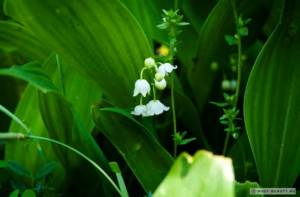
It grows in the taiga expanses of the Far East, Transbaikalia, China and Japan. In addition to forests, it grows in meadows and floodplains. Some botanists are inclined to consider the plant a variety of May lily of the valley, but most consider it a separate species. It differs from it:
- larger flowers;
- highly branched rhizome;
- late flowering;
- lower leaves are brown or purple
Keiske's stem is low (only 18 cm), the number of flowers on an inflorescence does not exceed ten.
Mountain

This species is a typical representative of the North American flora, found exclusively in the southeastern expanses of the United States. Its main difference from its May counterpart is its larger leaves and low stem. The inflorescence blooms with 5-15 flowers wide at the base. The red-orange berries of this species of lily of the valley appear in the fall, and not after flowering.
Transcaucasian
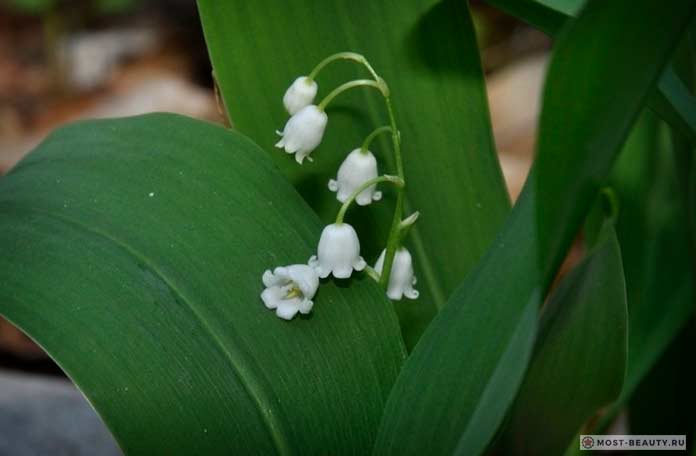
The name of the species gives the most obvious idea of its habitat. Its homeland is the territory of the Caucasus, but even there it is one of the rare species of lily of the valley. It has large flowers with expanded bells.
Ophiopogon

Although often referred to as Japanese lily of the valley, it is not actually one of its varieties, but is a member of the lily family. It grows in China, Japan, and the Himalayas. The plant is vaguely similar to an ordinary lily of the valley, but there is a certain similarity in the similarity of flowers and leaves. They also have in common their love of growing in the shade.
Caring for lilies of the valley
Lily of the valley adapts well to any weather conditions. But it does not tolerate drafts and direct sunlight.
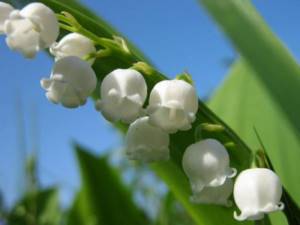
The downside is low frost resistance and late flowering. In the first case, after 6 years, in the second, after 3 years.
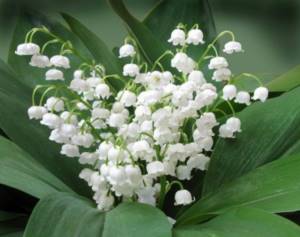
The best time for planting is mid-autumn. The soil is prepared in advance; fertilizers can be used. Each housewife plants in her own way, but in general terms, each flower should be planted at a distance of 10-15 cm, 15 cm deep into the ground and sprinkled with 1-2 cm of light soil.
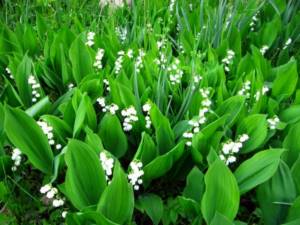
Water thoroughly with water at room temperature. In winter, cover with any materials to maintain warmth. Planting can also be done in the spring, but such a flower will be painful and will not bloom this season.
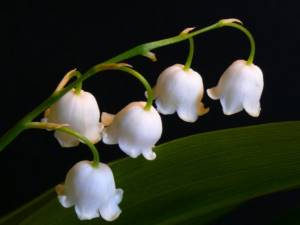
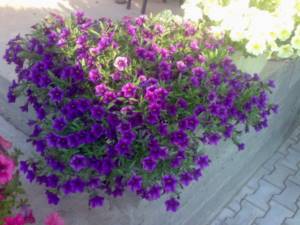
Bacopa - description of the species, cultivation, care, reproduction + 74 photos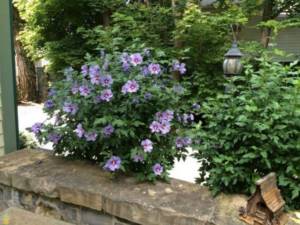
Garden hibiscus - types, description, planting, care and propagation + 69 photos
- Celosia - growing from seeds and seedlings, planting in the ground and care rules + 80 photos
They do not need care. You just need to maintain moisture, remove weeds and loosen the soil around from time to time.
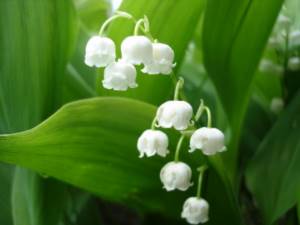
Lilies of the valley are very aggressive plants; in the overall bouquet they crowd out and lead to rapid withering and death of other flowers.
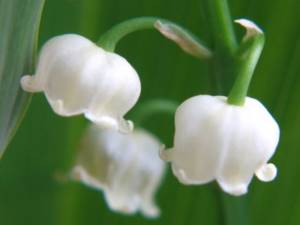
Main garden varieties
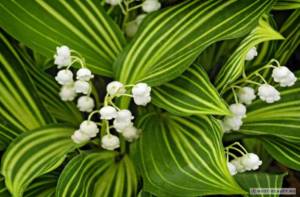
Albostriata has atypical leaves with creamy white stripes, while Lineata has yellow stripes. After flowering, these varieties continue to delight the eye with their decorative leaves. That is why they are most often used in landscape design.

Flore Plena is a variety with 12 double flowers on an inflorescence, the stem height of which reaches up to 25 cm.
Latifolia - the main difference is the flowers are of an atypical pink color and the leaves are wider than other species.
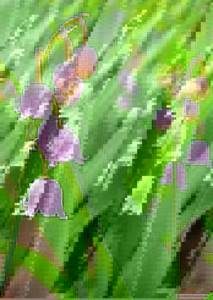
Pink petals are characteristic of Rosea flowers, of which up to 14 bloom on an inflorescence.
Yellow leaves come from Aurea, a variety that is distinguished by its most golden color.
Hardwick Hall is a modern variety with yellow-green edges on the leaves.
Viktor Ivanovich is an extravagant and tallest variety of lily of the valley, the stems of which can reach 50 cm. Up to two dozen large snow-white flowers bloom on the inflorescence. After they bloom, red fruits appear, giving the flower additional attractiveness.
What to add?
If no other flowers are used in the floral arrangement, it is advisable to complement the lilies of the valley with fresh bright greenery and/or openwork (lace) or satin ribbons that match the tone (since the plant’s own leaves quickly turn yellow).
Sometimes the bouquet is packed in special paper or a lace “frill”; even feathers are used as a frame. But in any case, it is advisable to wrap the lower part of the composition with something , since the bright green leaves can stain the bride’s gloves.

Who should buy a bridal bouquet? Details at the link .
Since “May flowers” are too modest, they are often used in combination with other flowers :
- With light-colored tulips , they add the meaning of “nobility” and “admiration” to the modesty of the May flower. Can also be interpreted as a symbol of luxury;
- Terry lilac - it symbolizes spring, and also sadness. Therefore, it is added to wedding bouquets in combination with other flowers, for example, roses of a suitable color;
- With freesia , the main meaning here is “trust”, “confidence”, serious intentions. This theme is perfect for a wedding;
- Callas - in the language of flowers they mean family happiness, building relationships;
- Peonies - they add femininity and tenderness to the basic meaning;
- Roses are an eternal classic of the genre. In combination with roses, lily of the valley takes on the meaning of solemn and at the same time passionate purity. With a huge variety of varieties and colors of roses, the possibilities for decorating a bouquet are almost limitless.
Artistic description of lily of the valley in legends

Beautiful lilies of the valley are surrounded by many romantic legends; they are often mentioned in fairy tales. For example, Snow White (from the Brothers Grimm fairy tale) running away from her stepmother scattered her necklace, which turned into beautiful snow-white spring flowers. Legends attribute to the plant the role of the abode of gnomes and elves. Other beautiful legends say that lilies of the valley in the forest serve as a night shelter for sunbeams.
The ancient Romans believed that the beautiful bell-shaped flowers were formed from droplets of sweat from the forest goddess Diana, running away from the fauns. According to an old Russian legend, lilies of the valley are the tears of the daughter of the water king, Volkhov, frozen in the greenery of spring grasses from unrequited love for the guslar Sadko.
Another legend presents them as pearls from the laughter of Mavka in love. Orthodox Christians consider lilies of the valley to be the tears of the Virgin Mary, the flowers of purity.
Legends and beliefs about lily of the valley
According to one legend, drops of sweat fell from the ancient Roman goddess of hunting Diana, from which beautiful lilies of the valley appeared. In another way, these are the magical tears of Snow White, in a third way, the laughter of a forest fairy. Someone tells children fairy tales about how lilies of the valley serve as lanterns for magical gnomes at night.
Back in the 17th century, a tradition arose in France to celebrate the arrival of spring, which takes place in the last week of April. People go to the forest for lilies of the valley and decorate their houses, clothes, and hairstyles with flowers. This is a big holiday, which is necessarily accompanied by feasting and dancing.
In esotericism, a bouquet of lily of the valley flowers is used to cleanse space and the human aura. It is believed that this simple flower prevents the penetration of negative energy into a person’s home.
Every country in the world has its own tradition or belief associated with this charming flower. For example:
- In Finland, the lily of the valley is one of the symbols of the country.
- In Holland, on their wedding day, it is customary for newlyweds to plant lilies of the valley to perpetuate their love.
Symbolism and interesting facts
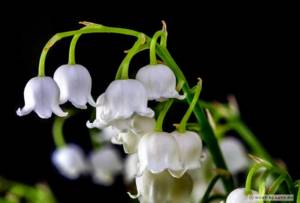
This spring plant has the most romantic symbolism - it is associated with tender feelings, sincere love, fidelity and purity of soul. It is not surprising that at all times they were admired by creative people, immortalized in poetic lines and on canvas.
In France, they even celebrate the day of this flower, which falls on May 1st. In Finland it is the national plant and is depicted on coins. It is believed that lilies of the valley received as a gift on May 1 and then dried can become a real amulet for happiness and good luck. In Holland, newlyweds should plant these flowers in the garden immediately after the wedding - as a sign of love that will never fade.
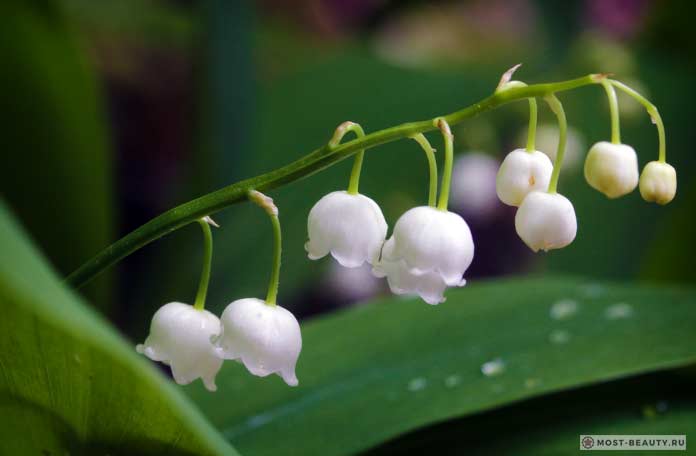
Composer Pyotr Tchaikovsky admired lilies of the valley. Considering them a source of inspiration, he even planted them in the park behind his house. An interesting fact is that in many portraits Nicolaus Copernicus was depicted with a bouquet of lilies of the valley in his hand. This is explained by the fact that the famous astronomer was also popular as a healer, and lilies of the valley were considered a symbol of healing.
Care Tips
The peculiarity of the flower is rapid fading . Therefore, it is not worth collecting a wedding bouquet of lilies of the valley in the forest. It is better to purchase a ready-made arrangement from experienced florists who will correctly “assemble” the bouquet, take care of its safety during the long day and give advice on caring for it after the wedding.
- In a combined bouquet, capsules with a preservative solution should be different for different groups of flowers ;
- Bright sun, drafts, strong wind and frost are contraindicated for any plants, but especially for lily of the valley;
- For winter weddings, such a bouquet is practically unsuitable , since the petals caught in the frost will quickly lose their appearance.
- At home, it is better to keep the composition in a dark, cool place ; it is better to take it out of the bedroom at night - the strong smell can cause a headache.
How to throw a bouquet at a wedding? Read more about this .
Bouquets of lilies of the valley
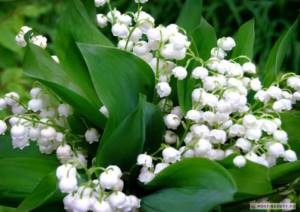
The beauty of these spring flowers is enchanting, but it is worth considering the characteristics of the plant when wanting to place a bouquet of them in the house. Taking into account the fact that all parts of the lily of the valley are poisonous (especially the berries), and its strong aroma can provoke headaches and even cause poisoning, it is important:
- place these flowers in a well-ventilated area;
- never place them in a bedroom or in a house where there are small children or animals who might eat flowers or berries
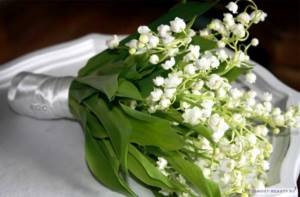
In order for these beautiful spring plants in a bouquet to retain their attractiveness longer, it is recommended not to tear off their leaves and add a drop of citric acid to the water where they will stand. The water should be changed every 1-2 days and the vase should never be placed in the sun.
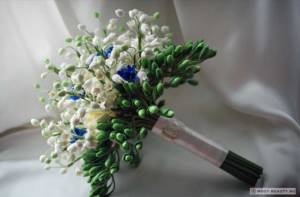
And you can find out about other beautiful bouquets on our website most-beauty.ru by following the link.
Compositions of lilies of the valley, symbolizing purity and sincerity of feelings, are often used in wedding decor and as a bridal bouquet. Mono-bouquets of these flowers are considered the most feminine and delicate.
Bouquets of lilies of the valley in combination with peonies will also naturally highlight the beauty and femininity of the bride. Depending on the color of the latter, you can get an option that emphasizes the delicate (pink flowers) or, conversely, the passionate (red) feelings of the newlyweds.
Interesting compositions are obtained when combined with the flower queen - a white rose, diluted with decorative greenery. Red, pink and even yellow roses can make no less harmonious company for snow-white lilies of the valley.
Tulips of any color look good when cut as snow-white forest beauties. The most beautiful compositions will be obtained if you combine these wildflowers with exquisite aristocrats - freesias.
Reference
It is generally accepted that you can buy a bouquet of lilies of the valley only at the end of spring, sometimes at the beginning of summer. That's when they bloom in our climate. But thanks to the successes of the greenhouse business, it is now possible to purchase a composition at any time of the year , since lilies of the valley with rhizomes are brought from Dutch greenhouses.
They are already planted in special containers or prepared for planting, so from such plants you can arrange either a traditional bouquet (by cutting off the stems with buds), or a basket or boutonniere.
Bottom line

The fragile and delicate lily of the valley flower with miniature snow-white bells enchants at first sight. This symbol of tenderness and boundless love, even in the photo, seems like a forest wizard, giving a feeling of joy. Its aroma may seem very strong to some, but its truly enchanting beauty is unlikely to leave anyone indifferent.
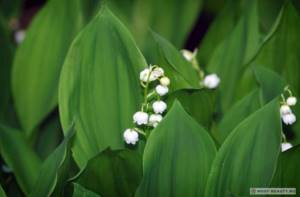
Author: skywriter13
Bridal bouquet of lilies of the valley: what do the flowers “say”?
There are many beautiful and sad legends associated with lilies of the valley. For example, according to an ancient Russian legend, a sea princess fell in love with an earthly youth. But his heart already belonged to someone else. Then the princess went ashore and burst into tears. And in the place where her tears fell, these wonderful flowers grew.
But no matter how many versions exist, all legends agree on one thing: spring lilies of the valley in a bride’s bouquet are a symbol of purity and tenderness in a relationship. Even through photographs, you will definitely be imbued with the beauty and sensuality of these fragile inflorescences.










